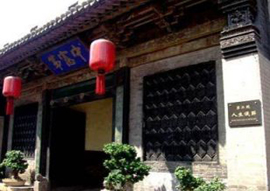The Qiao's Compound was built in the late 1700s by the influential Qiao family. With their successful business, the Qiao family enjoyed a prestigious status in the Qing Dynasty (1644-1911) during the  reign of Emperor Qianlong (1735-1796). One of the members of the Qiao family traveled around China and even to some foreign countries, which in turn made them famous throughout the nation. reign of Emperor Qianlong (1735-1796). One of the members of the Qiao family traveled around China and even to some foreign countries, which in turn made them famous throughout the nation.
The entire compound covers an area of 8,000 square meters and consists of six main courtyards and 19 smaller ones with 313 rooms altogether. From a pavilion in the southwest corner is a great way to have a bird's-eye view of the entire complex.
The inner courtyards and passages of the Qiao's Compound were designed to be in the shape of the Chinese "Shuangxi", which means Double Happiness. The roofs of the rooms are also in the shapes of water waves and mountain peaks. The whole compound features many elements of Chinese art and strong traditional cultural characteristics.
In 1985, the local government set up the Qixian County Folk Art Museum, which exhibited 5,000 objects of folk traditions on the Qiao grounds. Folk art, agricultural customs, clothing, food, shelter and means of travel were all included in the exhibition. Many films have also been shot here, including the internationally acclaimed Raise the Red Lantern, starring Gong Li. Information on these films are also exhibited in the compound. |
